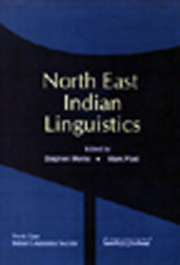Book contents
- Frontmatter
- Contents
- Introduction
- Foreword
- Phonology
- Lexicon
- Morphology, Syntax, and Semantics
- 9 Causative Prefixes in Four Boro-Garo Languages
- 10 Similarities in Verbal and Nominal Morphology In Atong
- 11 Temporality in Bishnupriya
- 12 Explicator Compound Verbs in Assamese and Kashmiri: A Comparative Analysis
- 13 Explorations in the Nonfinite Verbal System in Asamiya
- Language Description and Language Endangerment
13 - Explorations in the Nonfinite Verbal System in Asamiya
from Morphology, Syntax, and Semantics
Published online by Cambridge University Press: 26 October 2011
- Frontmatter
- Contents
- Introduction
- Foreword
- Phonology
- Lexicon
- Morphology, Syntax, and Semantics
- 9 Causative Prefixes in Four Boro-Garo Languages
- 10 Similarities in Verbal and Nominal Morphology In Atong
- 11 Temporality in Bishnupriya
- 12 Explicator Compound Verbs in Assamese and Kashmiri: A Comparative Analysis
- 13 Explorations in the Nonfinite Verbal System in Asamiya
- Language Description and Language Endangerment
Summary
Introduction
This paper is an attempt to redefine the notion of Nonfinite verb in Standard Asamiya (Assamese) and to provide a description of the verbal forms in the language on the basis of factual observations of the inventory of the nonfinite verbals in the language, thereby explicating their different uses and functions for fulfilling various communicative needs in the language.
A survey of the available works on the structure of Asamiya shows a dearth of attempts at a comprehensive treatment on the issue. The works of various traditional grammarians of the language, starting from Hemchandra Barua's pioneering work (first published in 1857) are more or less confined to providing a notional basis for the concept of nonfinite verbs, as evidenced from the term Asamapika Kriya (Incomplete verb) popularly used to refer to such verbal forms. The notion of ‘incompleteness’ has been defined by different scholars in various ways, by some as indicative of ‘non-completion of a sentence’ (Barua 1984:138), whereas by some as that of ‘non-completion of an action’ (Bora 2005:136), yet by some others as indicative of not only of ‘non-completion of a sentence, but also that of completion or progression of an action’ (Goswami 2003:295). Kakati (1972), the first ever analytic work carried out on the language, while subcategorizing such forms as conjunctives or gerunds, infinitives and participles has basically focused on their morphological derivation from a historical perspective only. However, all are unanimously in agreement that a nonfinite verb is an invariable form lacking concord in terms of the grammatical category of person.
- Type
- Chapter
- Information
- North East Indian Linguistics , pp. 221 - 240Publisher: Foundation BooksPrint publication year: 2008

